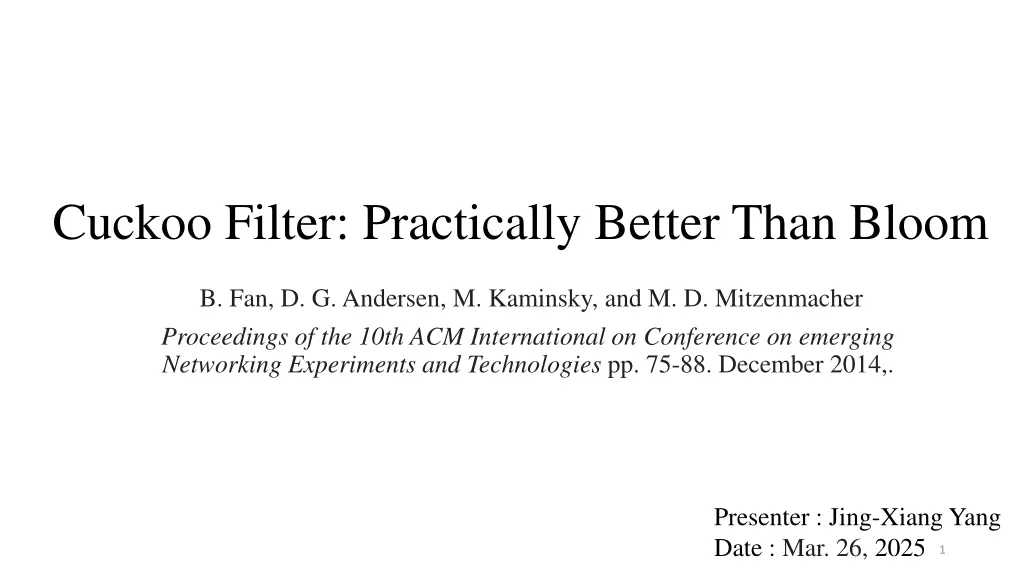
Cuckoo Filter: A Superior Alternative to Bloom Filters
Discover the advancements of Cuckoo Filters over Bloom Filters in networking systems, offering dynamic item addition and removal capabilities with enhanced performance and space efficiency. Uncover how Cuckoo Filters outperform traditional methods and optimize set membership tests while supporting deletions.
Download Presentation

Please find below an Image/Link to download the presentation.
The content on the website is provided AS IS for your information and personal use only. It may not be sold, licensed, or shared on other websites without obtaining consent from the author. If you encounter any issues during the download, it is possible that the publisher has removed the file from their server.
You are allowed to download the files provided on this website for personal or commercial use, subject to the condition that they are used lawfully. All files are the property of their respective owners.
The content on the website is provided AS IS for your information and personal use only. It may not be sold, licensed, or shared on other websites without obtaining consent from the author.
E N D
Presentation Transcript
Cuckoo Filter: Practically Better Than Bloom B. Fan, D. G. Andersen, M. Kaminsky, and M. D. Mitzenmacher Proceedings of the 10th ACM International on Conference on emerging Networking Experiments and Technologies pp. 75-88. December 2014,. Presenter : Jing-Xiang Yang Date : Mar. 26, 2025 1
ABSTRACT In many networking systems, Bloom filters are used for high speed set membership tests. They permit a small fraction of false positive answers with very good space efficiency. However, they do not permit deletion of items from the set, and previous attempts to extend standard Bloom filters to support deletion all degrade either space or performance. We propose a new data structure called the cuckoo filter that can replace Bloom filters for approximate set member ship tests. Cuckoo filters support adding and removing items dynamically while achieving even higher performance than Bloom filters. For applications that store many items and target moderately low false positive rates, cuckoo filters have lower space overhead than space-optimized Bloom filters. Our experimental results also show that cuckoo filters out perform previous data structures that extend Bloom filters to support deletions substantially in both time and space. 2
Bloom Filter Purpose: Quickly checks if an item might exist or is definitely absent Use Cases : Prevent unnecessary requests Quickly check if data is cached Insert 3
Look up might exist 4
Look up definitely absent 5
Counting Bloom Filter Support deletion (using counter) 7
Cuckoo Filter Bloom filter requires less memory than standard hashing methods hashing. Cuckoo Filter is designed to support deletions and improve efficiency. 8
Cuckoo Filter (Insert) X = 5 Fingerprint(x) = 123 i1= 2, i2= 4 Backet 123 10
Cuckoo Filter (Insert) X = 6 Fingerprint(x) = 777 i1 = 1, i2 = 4 Backet 777 123 11
Cuckoo Filter (Insert) X = 7 Fingerprint(x) = 88 i1 = 1, i2 = 3 Backet 777(88) 123 777 12
Cuckoo Filter (Insert) X = 7 Fingerprint(x) = 88 i1 = 1, i2 = 3 Backet 777 88 123 Actually, a bucket has multiple slots. 13
Cuckoo Filter (Look up) X = 6 Fingerprint(x) = 777 i1 = 1, i2 = 4 Backet 88 123 777 might exist 15
Cuckoo Filter (Look up) X = 99 Fingerprint(x) = 234 i1 = 0, i2 = 3 definitely absent Backet 88 123 777 16
Cuckoo Filter (Delete) X = 7 Fingerprint(x) = 88 i1 = 1, i2 = 3 Backet 88 123 777 17
Load Factor A short fingerprint ensures good load balancing. 18
Analysis Spatial utilization is better than many other variations. 19
Thanks 20
